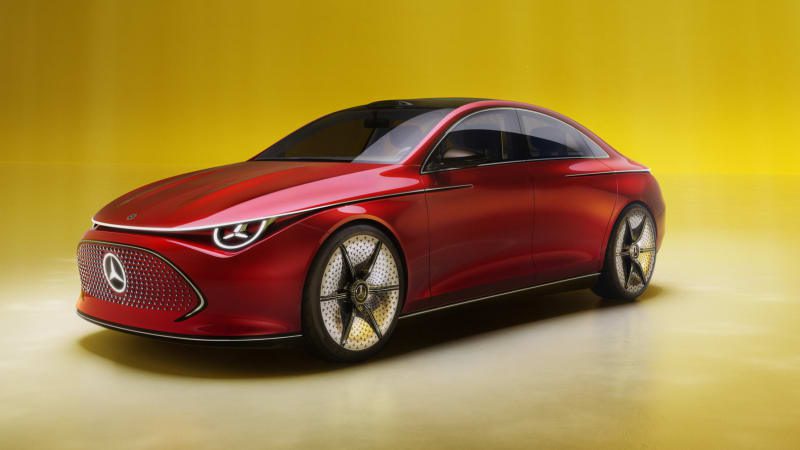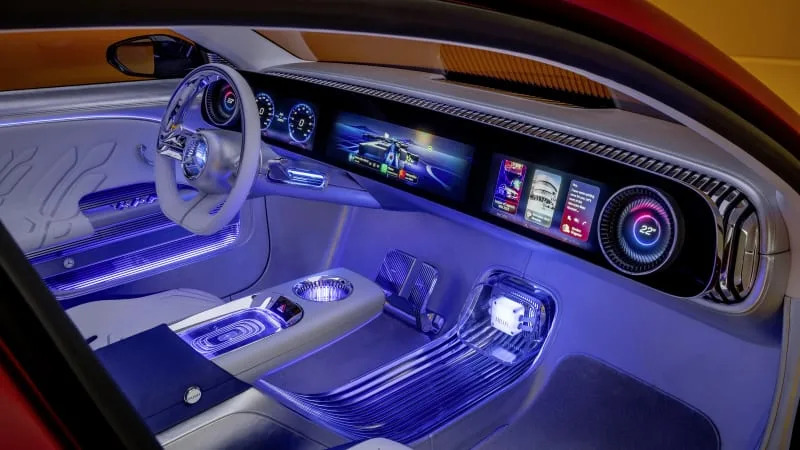Mercedes-Benz Concept CLA Class is huge tech in a small, bright package

This is the first step in the next step of the electric revolution happening at Mercedes-Benz. Unveiled at IAA Mobility 2023 in Munich and called the Concept CLA Class, the battery-electric four-door previews a production car placed at the “entry luxury” gateway to Mercedes’ lineup. In doing so, it sits on the new EV-focused Mercedes-Benz Modular Architecture (MMA), incorporates much of the science that went into the hypermiling battery-electric Vision EQXX, and wraps those advances in sheetmetal reminiscent of the current CLA. The entry-level electric will eventually offer four bodystyles: This sedan, a wagon, and two SUVs.
In sedan form, Europeans are promised a range of more than 750 kilometers (466 miles) on a charge on the WLTP cycle. Heaps of innovations went into delivering that kind of economy; Mercedes said “efficiency is the new currency” in the EV market, so engineers worked to make gains in every component. The retail model will offer two battery chemistries, a new pack developed with battery partner CATL being the range champ. The automaker didn’t specify a capacity for the future product, but quoted energy consumption for the high-range pack as 12 kWh per 100 kilometers or 5.2 miles per kWh. Those numbers mean a battery with around 90 kWh usable to reach 750 km/466 mi. For comparison, Volvo’s spec for the battery in the Euro-market 2024 XC40 Recharge is 18.2 kWh per 100 kilometers or 3.2 miles per kWh, roughly one-third less efficient than the Mercedes numbers.
The new, modular pack is said to take up a smaller volume compared to a current pack of similar capacity. The cell modules are held in place with adhesive instead of screws, lowering the weight of the pack and supposedly improving stiffness. The long-range chemistry features silicon-oxide anodes in what we expect is a lithium-ion battery chemistry. The entry-level pack is lithium-iron phosphate. Power is routed through an 800-volt electrical architecture. Mercedes says that at the max 250-kW DC fast-charge rate, the battery will gain 248 miles of range in 15 minutes. The production version will be capable of bi-directional charging as well.
The in-house electric drive unit is a compact package containing a 175-kW e-motor with almost no heavy rare earth metals, a two-speed transmission, and power electronics using silicon carbide semiconductors that can handle higher energy densities more efficiently. The unit’s chiseled down to a weight of less than 243 pounds. Mercedes says it has measured system-wide energy efficiency of up to 93% in long distance driving, in part thanks to a heat pump that can draw heat out of the ambient air even in sub-freezing temperatures to maintain the battery’s ideal operating range.
The bodywork surrounding the powertrain has a lot going on. First, it’s larger than the current production CLA, meaning more headroom and legroom for all occupants. Up front, it takes vintage inspiration in its so-called “shark nose” front fascia, named for the very slight forward lean. However, the very-low-energy LED light show that begins here and wraps around the vehicle is all about today and the future. Branding works triple time, designers working Mercedes’ three-pointed star into the headlights, into animated light bands in the reworked A-frame grille, into the animations that appear in the glass roof, and the taillights. The front and rear Mercedes badges are illuminated. There’s more animation possible in the light bands that stretch around to the car’s sides “such as welcome and goodbye scenarios” the driver can personalize. When those sidelights are off, they’re said to take on the look of mirrored chrome. Since this is a concept, who knows if this aspect makes it to production.
In the cabin, which looks like a “Guardians of the Galaxy” set, Hyperscreen is out, Superscreen is in. A direct descendant of the full-width screen-slash-instrument panel in the EQXX, the Concept CLA Class interior is based around the “MBUX Superscreen” composed of three displays and set into a single-piece aluminum housing. The Unity game engine controls 3D graphics on the low-energy mini-LED screen, one of its greatest gee-whiz effects used for the HVAC system. The screen shows a pair of turbine-look digital vents at the far corners that act as the climate control interface, the digital vent centers displaying the current settings. The actual vents are behind the screen, integrated to look like cooling ribs for the screen and act as ambient light sources. When someone wants to change the settings, a physical, machined ring ring emerges from the glass Superscreen. Turning that physical ring changes the climate control.

The total range of the futuristic color palette counts “crystal white,” “gleaming silver,” “cool blue,” and “sensual violet.” The emphasis for the concept, though, is clearly a bright cyberpunk kind of cool blue. The luxury materials are a menu of sustainable sourcing. Leather — the real thing, from cows — tanned with vegetable-based agents gets stitched up in places like the groovy seats. The floor mats are made from bamboo. Pockets in the door card are lined with a vegan silk-like fabric.
We’re certain we’ll need a week and a Deep Dive piece to learn everything the new MB.OS software can do. The automaker went all out on the hardware so that it can upgrade the software — for a fee, no doubt — well into the future. For now, know that the company plans for the production vehicle to be “an entertainment and gaming center, a productivity zone, a private oasis, even part of a server farm and the energy grid — an integral part of life.” The retail model will come with Level 2 assisted driving capability, upgradeable to Level 3 when cars roll off the line with more LIDAR-integrated sensors. And there’s a child detection system throughout the cockpit of such sensitivity that it can detect the breathing pattern of a sleeping newborn baby. Try leaving a kid in the car, the system will start with warning chimes, escalate to sending messages to the Mercedes.me account registered to the car, monitor the cabin for dangerous temperatures and turn on the A/C if necessary, all the way to notifying first responders.
There’s a lot more to come from this car, so stay tuned.



